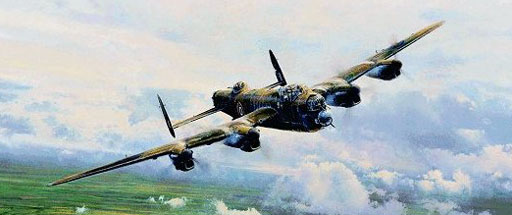A.V.R.O. Lancaster

The Avro Lancaster was a British four-engine Second World War bomber aircraft made initially by Avro for the British Royal Air Force (RAF). It first saw active service in 1942, and together with the Handley-Page Halifax it was one of the main heavy bombers of the RAF, the Royal Canadian Air Force and squadrons from other Commonwealth and European countries serving with RAF Bomber Command.
The "Lanc" or "Lankie", as it became affectionately known, became the most famous and most successful of the Second World War night bombers, "delivering 608,612 tons of bombs in 156,000 sorties." Although the Lancaster was primarily a night bomber, it excelled in many other roles including daylight precision bombing, and gained worldwide renown as the "Dam Buster" used in the 1943 Operation Chastise raids on Germany's Ruhr Valley dams.
The origins of the Lancaster lie in a twin-engined bomber design powered by Rolls-Royce Vulture engines submitted to Specification P.13/36 which was for a new generation of twin-engined medium bombers. The resulting aircraft was the Avro Manchester, which, although a capable aircraft, was troubled by the unreliability of the Vulture and withdrawn from service in 1942, by which point 200 aircraft had been built. Avro's chief designer, Roy Chadwick, was already working on an improved Manchester design using four of the more reliable but less powerful Rolls-Royce Merlin engines on a larger wing. The aircraft was initially designated Avro Type 683 Manchester III, and later re-named the Lancaster.
The prototype aircraft BT308 was assembled by Avro's experimental flight department at Manchester's Ringway Airport from where test pilot H.A. "Bill" Thorn took the controls for its first flight on Thursday, 9 January 1941. The aircraft proved to be a great improvement on its predecessor, being "one of the few warplanes in history to be 'right' from the start." Its initial three-finned tail layout, a result of being converted from a Manchester I, was quickly changed on the second prototype DG595 and subsequent production aircraft to the familiar twin-finned specification used on the later Manchesters (below).
Some of the later orders for Manchesters were changed in favour of Lancasters; the designs were very similar and both featured the same distinctive greenhouse cockpit, turret nose and twin tail. The Lancaster discarded the stubby central third tail fin of the early Manchesters and used the wider span tailplane and larger elliptical twin fins from the later Manchester IA.
The majority of Lancasters built during the war years were manufactured by Avro at their factory at Chadderton near Manchester and test flown from Woodford Aerodrome in Cheshire. Other Lancasters were built by Metropolitan-Vickers and Armstrong Whitworth.
The aircraft was also produced at the Austin Motor Company works in Longbridge, Birmingham later in the Second World War and postwar at Chester by Vickers-Armstrongs. Only 300 of the Lancaster B II with Bristol Hercules engines were constructed. The Lancaster B III had Packard Merlin engines but was otherwise identical to contemporary B Is, with 3,030 B IIIs built, almost all at A.V. Roe's Newton Heath factory. The B I and B III were built concurrently, and minor modifications were made to both marks as new batches were ordered. Examples of these modifications were the relocation of the pitot head from the nose to the side of the cockpit, and the change from de Havilland "needle blade" propellers to Hamilton Standard or Nash Kelvinator made "paddle blade" propellers.
A total of 7,377 Lancasters of all marks were built throughout the duration of the war, each at a 1943 cost of £45-50,000 (approximately equivalent to £1.3-1.5 million in 2005 currency). The test pilot Alex Henshaw is the only known pilot to have barrel rolled a Lancaster bomber, a feat considered almost impossible because of the slow speed of the aircraft.
General characteristics
Crew: 7: pilot, flight engineer, navigator, bomb aimer, wireless operator, mid-upper and rear gunners Length: 69 ft 5 in (21.18 m)
Wingspan: 102 ft (31.09 m)
Height: 19 ft 7 in (5.97 m)
Wing area: 1,300 ft² (120 m²)
Empty weight: 36 828 lb (16,705 kg)
Loaded weight: 63,000 lb (29,000 kg)
Powerplant: 4× Rolls-Royce Merlin XX V12 engines, 1,280 hp (954 kW) each
Performance Maximum speed: 240 knots (280 mph, 450 km/h) at 15,000 ft (5,600 m)
Range: 2,700 nm (3,000 mi, 4,600 km) with minimal bomb load Service ceiling: 23,500 ft (8,160 m)
Wing loading: 48 lb/ft² (240 kg/m²)
Power/mass: 0.081 hp/lb (130 W/kg)
Armament Guns: 8× 0.303 in (7.70 mm) Browning machine guns in three turrets
Bombs:
Maximum: 22,000 lb (10,000 kg)
Typical: 14,000 lb (6,400 kg)